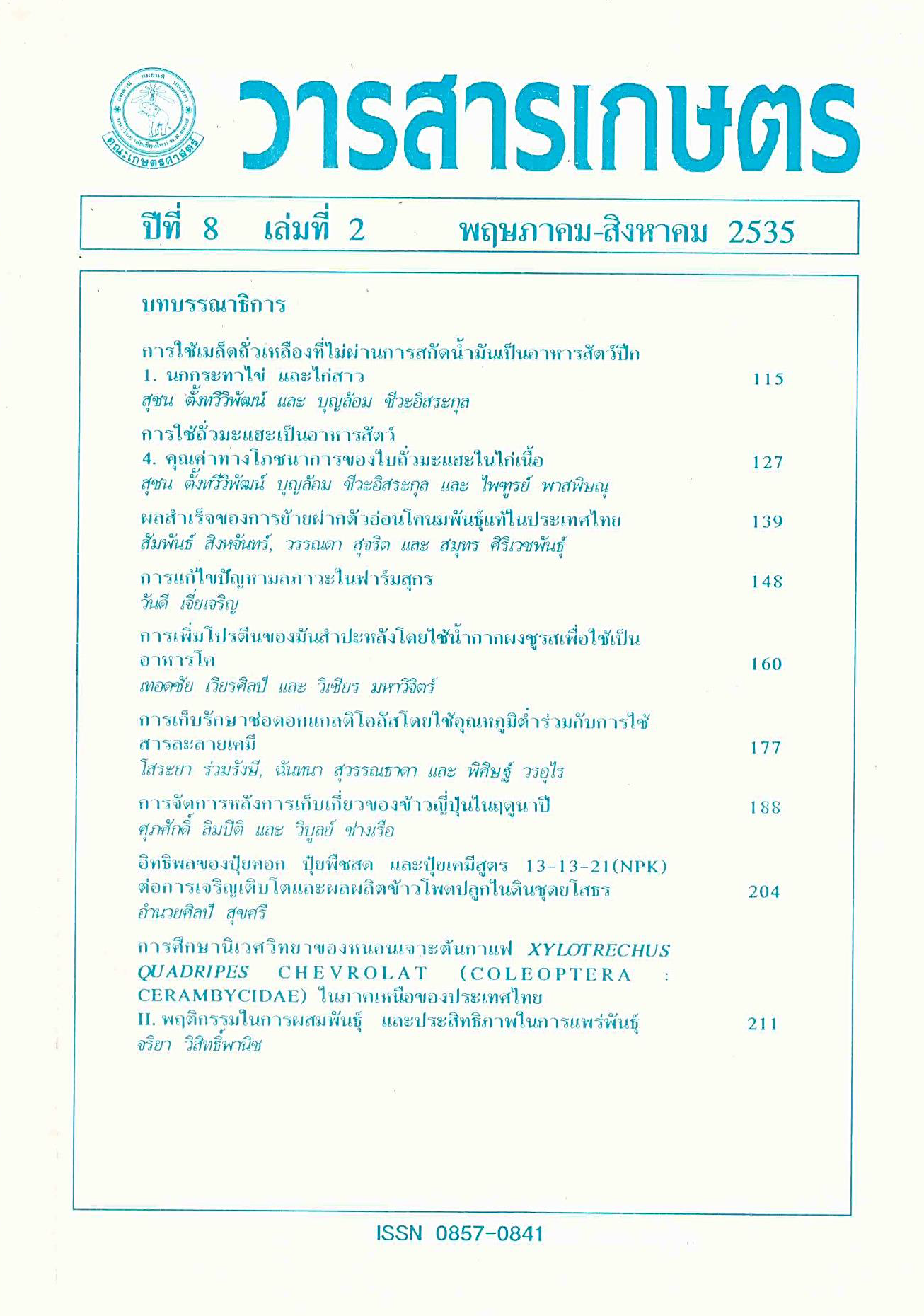การเพิ่มโปรตีนของมันสำปะหลังโดยใช้น้ำกากผงชูรสเพื่อใช้เป็นอาหารโค
Main Article Content
บทคัดย่อ
ใช้มันสำปะหลังเส้นบดผสมน้ำกากผงชูรสในอัตราส่วน 21, 2.5: 1, 3.0: 1 และ 3.5: 1 เป็นอาหารข้นเลี้ยงโคขาวลำพูนจำนวน 16 ตัว ที่แบ่งเป็น 4 กลุ่ม ปรากฏว่า โคทดลองกินมันสำปะหลังเส้นบดผสมน้ำกากผงชูรสในอัตราส่วน 3.5: 1 ได้สูงสุด (P<0.05) และใช้มันสำปะหลังเส้นบดผสมน้ำกากผงชูรสในอัตราส่วน 3.5:1 นี้ทดแทนข้าวโพดบดในระดับ 0, 50, 75 และ 100% ปรากฏว่า มีการเจริญเติบโต 74กข, 865ก, 778กข และ 695ข กรัม/ตัว/วัน ตามลำดับ และพบว่า ราคาอาหารข้น (บาท/กก.) และต้นทุนการผลิตต่อน้ำหนักตัวที่เพิ่มขึ้นจะลดลงตามอัตราส่วนของการใช้มันสำปะหลังเส้นบดผสมน้ำกากผงชูรสทดแทนข้าวโพดที่เพิ่มขึ้น โคทดลองทุกกลุ่มมีคุณภาพซากใกล้เคียงกัน โคที่มีอายุมากกว่า 2.5 ปี จะมีปริมาณการกินอาหารและต้นทุนการผลิตด้านอาหารสูงกว่าโคที่อายุน้อยกว่า 2.5 ปี (P<0.01) แต่มีอัตราการเจริญเติบโตและคุณภาพซากใกล้เคียงกัน.
Article Details
เอกสารอ้างอิง
คันธพนิต, ชัยณรงค์. (2529). วิทยาศาสตร์เนื้อสัตว์. สำนักพิมพ์ไทยวัฒนาพานิช จำกัด, กรุงเทพฯ. 276 น.
วิสิทธิ์พานิช, ธีระ. (2534). การศึกษาผลของใช้น้ำกากผงชูรสเสริมในอาหารสุกรรุ่น-ขุน. ภาควิชาสัตวบาล คณะเกษตรศาสตร์ มหาวิทยาลัยเชียงใหม่, เชียงใหม่. 19 น.
เวียรศิลป์, เทอดชัย. (2530). ปริมาณและอัตราการย่อยได้ของแป้งข้าวโพดในวัวนมที่เลี้ยงด้วยเมล็ดข้าวโพดในส่วนต่างๆของทางเดินอาหารของวัวนม. วารสารวิทยาศาสตร์เกษตร 3(1) ะ 1-18.
ศรีจันทร์, สมบัติ. (2530). อิทธิพลของพันธุ์โค อายุโค และชนิดอาหารหยาบในการเลี้ยงโคขุน. วิทยานิพนธ์ปริญญาโท มหาวิทยาลัยเกษตรศาสตร์, กรุงเทพฯ.
สถาปนศิริ, เกรียงศักดิ์., เวียรศิลป์, เทอดชัย., และวัชรพุกก์, ชาญวิทย์. (2533). การย่อยได้ของแป้งจากมันสำปะหลังเส้นข้าวเปลือกเจ้าบด และปลายข้าวเจ้า ในแต่ละส่วนของทางเดินอาหารของวัวนม วารสารเกษตร 6(4): 265-280.
อายิโนะโมะโต๊ะ (2532). รายงานผลการวิเคราะห์น้ำกากผงชูรส. เอกสารโรเนียว
อักบัดอารี, พินิจ. (2533). การใช้มันสำปะหลังผสมกากผงชูรส (Ami-Ami) เป็นแหล่งพลังงานในไก่เนื้อ. ปัญหาพิเศษ ปริญญาตรี. มหาวิทยาลัยเชียงใหม่, เชียงใหม่.
Ahrens, F.W. (1965). Histamine, lactic acid and hypertonicity as factors in the developement of rumenitis, pp. 612-625. Cited by G. Dirkson. Acidosis. Oriel Press, Newcastle.
Avante, D.C., Yoshihara, H., Peralta, N.E., Cayton, R.V., Escanolor, N.B. and Sison, J.A. (1982). A study on the effects of Fermented Mother Liquid as a substitute of soybean meal with and without L-lysine and DL-methionine supplementation in broiler ration. Philipp. J. Anim. Ind. 37: 52-61.
Avante, D.C., Flores, W.P., Soyama, S., Sison, J.A., Dumag, P.U. and de Leon, F.F. (1980). A preliminary study on the effects of Fermented Mother Liquid (FML) as a partial substitute for cane molasses in layer ration. Philipp. J. Anim. Ind. 35: 28-35.
Bergen, W.G. (1972). Rumen osmotality as a factor in feed intake control of sheep. J. Anim. Sci. 34: 1054.
Cardon, B.P. (1953). Influence of a high salt intake on cellulose digestion. J. Anim. Sci. 12: 536. Chanchareonsook, J., Sangborisut, P. and Vacharotayan, S. (1989). Utilization of waste materials from Monosadium Glutamate Factory as source of nitrogen for Paddy in Acid Sulfate Soil. Kasetsart J. 23: 93-97.
Flores, W.P., Avante, D.C., Soyama, s., Sison, J.A. and Dumag, P.U. (1980). A preliminary study on the effects of Fermented Mother Liquid (FML) as a substitute for cane molasses in broiler ration. Philipp. J. Anim. Ind. 35: 20-27.
Georgievshii, V.I. (1982). The physiological role of macroelements, PP 147-157. In: V.F. Georgievshii, B. N. Annenkov and V. T. Samokhin (eds.). Butterworth, London.
Hungate, R.E. (1966). The Rumen and Its Microbes. Academic Press, New York. 533 p.
Ridenour, K.W., Kiesling, H.E., Lofgreen, G.P. and Stiffler, D.M. (1982). Feedlot performance and carcass characteristics of beef steers grown and finished under different nutrition and management programs. J. Anim. Sci. 54: 1115-1119.
Rooney, L.W., and Pflugfelder, R.L. (1986). Factors affecting starch digestibility with special emphasis on sorghum and corn. J. Anim. Sci.63: 1607-1623.
Silverio, V.G., Soyama, S., Baoy, G.T., Aleantara, J. and Agpaoa, E.V. (1980). A study on the effects of Fermented Mother Liquid as subsitute of cane molasses on the performance of growing-finishing pigs. Philipp. J. Anim. Ind. 35: 36-49.
Steel, R.G.D. and Torrie, J.H. (1980). Principle and procedures of Statistics. McGraw-Hill Co., New York. 197 p.
Stevens, C.E. (1988). Comparative physiology of the vetebrate digestive system. Cambridge University Press, New York. 300 p.
Ternouth, J.H. (1967). A factor limiting the ruminant's voluntary consumption of silage. J. Aust. Inst. Agric. Sci. 33: 263.
Ternouth, J.H. and Beattie, A.W. (1971). Studies of the food intake of sheep at a single meal. Br. J. Nutr. 25: 153.
Tomas, F.M. and Potter, B.J. (1957). Influence of saline drinking water on the flow and mineral composition of saliva and rumen fluid of sheep. Aust J. Agric. Res. 26: 585.
Warner, A.C.I. and Stacy, B.D. (1977). Influence of ruminal and plasma osmotic pressure on salivary secretion in sheep. Q. J. Exp. Physiol. 62: 133.
Wilson, A.D. (1966). The tolerance of sheep to sodium in food or drinking water. Aust. J. Agric. Res. 17: 503.


